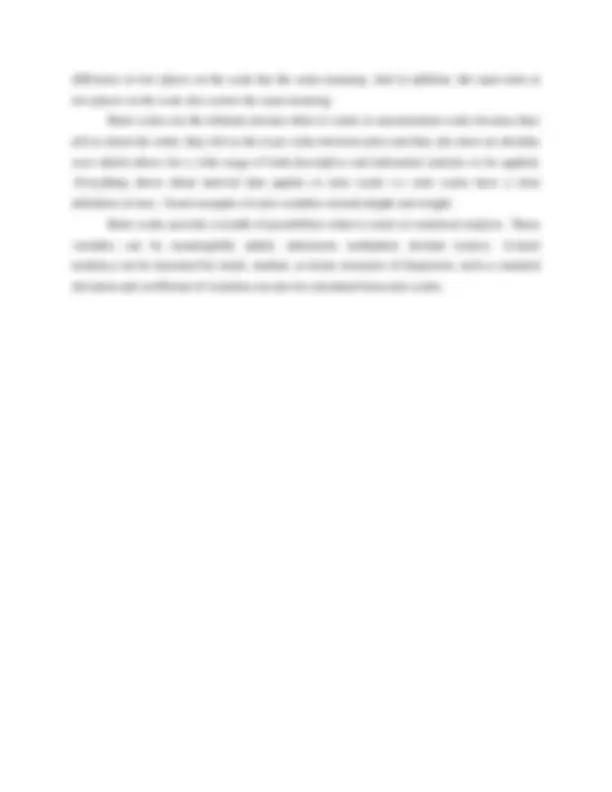



Study with the several resources on Docsity

Earn points by helping other students or get them with a premium plan


Prepare for your exams
Study with the several resources on Docsity

Earn points to download
Earn points by helping other students or get them with a premium plan
Community
Ask the community for help and clear up your study doubts
Discover the best universities in your country according to Docsity users
Free resources
Download our free guides on studying techniques, anxiety management strategies, and thesis advice from Docsity tutors
Psychologist Stanley Smith Stevens developed the best known classification with four levels or scales of measurement: nominal, ordinal, interval, and ratio.
Typology: Study notes
1 / 3

This page cannot be seen from the preview
Don't miss anything!


Level of measurement or scale of measure is a classification that describes the nature of information within the numbers assigned to variables. Psychologist Stanley Smith Stevens developed the best known classification with four levels or scales of measurement: nominal, ordinal, interval, and ratio. Stevens proposed his typology in a 1946 Science article titled "On the theory of scales of measurement". In this article, Stevens claimed that all measurement in science was conducted using four different types of scales that he called "nominal" "ordinal" "interval" and "ratio" unifying both "qualitative" (which are described by his "nominal" type) and "quantitative" (all the rest of his scales). The concept of scale types later received the mathematical rigor that it lacked at its inception with the work of mathematical psychologists Theodore Alper (1985, 1987), Louis Narens (1981a, b), and R. Duncan Luce (1986, 1987, 2001). As Luce (1997, p. 395) wrote; S. S. Stevens (1946, 1951, and 1975) claimed that what counted was having an interval or ratio scale. Subsequent research has given meaning to this assertion, but given his attempts to invoke scale type ideas it is doubtful if he understood it himself ... no measurement theorist I know accepts Stevens’ broad definition of measurement ... in our view, the only sensible meaning for 'rule' is empirically testable laws about the attribute.
1. Nominal Scale:
A nominal scale of measurement deals with variables that are non-numeric or where the numbers have no value. The lowest measurement level you can use, from a statistical point of view, is a nominal scale. A nominal scale, as the name implies, is simply some placing of data into categories, without any order or structure. A physical example of a nominal scale is the terms we use for colours. The underlying spectrum is ordered but the names are nominal. In research activities a YES/NO scale is nominal. It has no order and there is no distance between YES and NO.
2. Ordinal Scale:
The ordinal type allows for rank order (1st, 2nd, 3rd, etc.) by which data can be sorted, but still does not allow for relative degree of difference between them. An ordinal scale of measurement looks at variables where the order matters but the differences do not matter. When you think of 'ordinal,' think of the word 'order.' In the case of letter grades, we don't really know how much better an A is than a D. We know that A is better than B, which is better than C, and so on. But is A four times better than D? Is it two times better? In this case, the order is important but not the differences. Examples include, on one hand, dichotomous data with dichotomous (or dichotomized) values such as 'sick' vs. 'healthy' when measuring health, 'guilty' vs. 'innocent' when making judgments in courts, 'wrong/false' vs. 'right/true' when measuring truth value, and, on the other hand, non-dichotomous data consisting of a spectrum of values, such as 'completely agree', 'mostly agree', 'mostly disagree', 'completely disagree' when measuring opinion.
3. Interval Scale:
Interval scales are numeric scales in which we know not only the order, but also the exact differences between the values. The classic example of an interval scale is Celsius temperature because the difference between each value is the same. For example, the difference between 60 and 50 degrees is a measurable 10 degrees, as is the difference between 80 and 70 degrees. Time is another good example of an interval scale in which the increments are known, consistent, and measurable.
4. Ratio Scale:
The ratio scale of measurement is the most informative scale. It is an interval scale with the additional property that its zero position indicates the absence of the quantity being measured. You can think of a ratio scale as the three earlier scales rolled up in one. Like a nominal scale, it provides a name or category for each object (the numbers serve as labels). Like an ordinal scale, the objects are ordered (in terms of the ordering of the numbers). Like an interval scale, the same